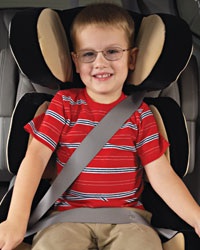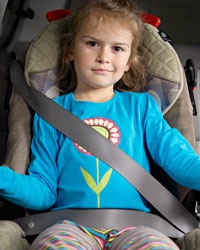All boosters are not created equally, according to a recent report by the Insurance Institute for Highway Safety (IIHS) that rates the belt fit of many booster models. A booster should route the lap belt flat across a child’s upper thighs, position the shoulder belt at mid-shoulder, and consistently fit this way in a variety of vehicles. The IIHS has revised its evaluation system since its prior report from 2008.
The IIHS Booster Rating System
Boosters (BPBs) that the IIHS rated BEST BETS are ones it found would most likely position lap-shoulder belts correctly in many cars, minivans, and SUVs. GOOD BETS provide acceptable lap-shoulder belt fit in almost as many vehicle belt configurations as the BEST BET BPBs. The NOT RECOMMENDED rating was given to specific boosters that often provided poor belt fit in the tests.
Out of 60 models assessed with the new protocol, the IIHS rated nine as BEST BETS, six as GOOD BETS, and eleven as NOT RECOMMENDED. The other 34 BPBs provided good fit in some configurations but not in others. The IIHS noted that there are benefits to both backless and highback models and therefore did not state a preference between these styles. Rather, the report reiterated that the IIHS considers good belt fit to be the most important factor for any booster style.
The Process
IIHS developed a test vehicle seat with adjustable belt anchorage locations to represent the most common “geometries“ (locations of seat belt anchors) seen in current vehicles. Each BPB was tested with four combinations of lap-shoulder belt anchor positions on this test seat. The Hybrid III 6-year-old anthropomorphic test device (ATD), which measures about 45 inches in height (25 inches in seated height), was used to represent the child. Specific placement of the dummy was clearly identified for consistency in the test protocol. Measurements were then taken and assigned scores.
The previous round of IIHS belt fit ratings was released in 2008 (IIHS Status Report, Vol. 43, No. 8; also see article in SRN Sept/Oct 2008). For 2009, the evaluation system was redeveloped to improve reliability and increase potential for manufacturers to reproduce the results during their own product assessments. Consequently, direct comparison of the 2008 results with these revised ratings is not possible.
To ensure that they understand these revised ratings, manufacturers representatives were invited to IIHS headquarters for in-depth discussions and demonstrations of the evaluation process three months prior to the December 2009 release of the revised ratings.
Evolution of the Ratings
The IIHS has been interested for many years in the belt fit provided by BPBs and its impact on their effectiveness. Back in 2001, when the U.S. Senate was considering strategies to make children safer on U.S. roadways, most advocates agreed that enhancing and extending child occupant protection laws was the answer. That year, Safe Kids Worldwide (then known as the National SAFE KIDS Campaign) rated state laws and found that only two states (CA and WA) had laws that covered booster-size children.
In his testimony to the Senate, Dr. Adrian Lund, now the president of the IIHS, surprised many with his comments on behalf of the IIHS. Based on IIHS research of BPB fit, he said, “The Institute believes emphasizing boosters is a misplaced priority.”
He then showed photos of booster fit on real children and dummies from assessments IIHS had performed of 63 boosters, lending validity to his claims. In Dr. Lund’s words, improvement of belt fit by boosters “depends on the specific child, the specific booster seat, and the specific car model in which the two are positioned.”
So, although the concept of a booster as a belt-positioning device was not questioned, the IIHS found that BPB designs too often did not do enough to achieve ideal belt fit.
Those early warnings from the IIHS did not go unnoticed by manufacturers. At least one booster cited during the hearing was almost immediately redesigned to provide better lap belt fit. Many manufacturers continue to conduct internal product reviews and research testing, including developing improvements to test dummies that would make the results of the sled testing of BPBs more meaningful.
Industry Response
Manufacturers and advocates have given mixed responses to the 2009 IIHS ratings report.
The Juvenile Products Manufacturers Association (JPMA), representing its CR manufacturer members, drew attention to the fact that there is no real-world field performance data of injuries in boosters that relate to poorly fitting belts. The organization points out that available data show that BPBs, whether BEST BET or NOT RECOMMENDED by the IIHS, have proven to reduce serious injuries to real children. Manufacturers recognize that there is a wide variation in vehicle seats and seat belt systems that can affect belt fit with the BPB and the child, and that not all combinations provide ideal seat belt fit. The JPMA and manufacturers have urged the IIHS to reassess the ratings published and balance them with real-world experience.
Safe Kids Worldwide also expressed early concern, indicating that real-world booster use and belt fit are far more important than ratings. The organization advises parents and caregivers to assess the specific fit of their vehicle belts on their children using boosters, rather than depend on ratings.
Consistent with both major commenters, the IIHS offers the following advice to caregivers who already own boosters on the NOT RECOMMENDED list: “Don’t throw it away. Any booster seat is better than none at all. But take a look at the belt fit, and if it’s not doing a good job, replace it when you can with one that works better.”
What CPSTs Can Do
Although the booster section of the certification curriculum covers proper belt fit, it does not mention that BPB models may vary in their ability to provide it. CPSTs can use these IIHS ratings as one tool to consider fit. However, because not all booster users have the dimensions of the Hybrid III 6-year-old, real-life assessment of BPBs should consider both the actual child occupant and the vehicle(s) being used.
CPSTs can advise caregivers to use the seat belt-fit criteria described in the National CPS Certification Program training to assess belt fit in a BPB as well as for the lap-shoulder belt use alone. These criteria are drawn from the 5-Step Test published by SafetyBeltSafe U.S.A. See the box below for helpful online resources.
Seat Belt Fit Criteria
Guidelines are available to help assess proper seat belt fit on children. In general, these guidelines can also be used to assess proper fit for a child using a BPB. Here are some resources that describe how to assess “good fit.”
- National CPS Certification Student Manual, Module 10, page 10-10
- Safe Kids Safety Belt Fit Test
- SafetyBeltSafe U.S.A. 5-Step Test
If caregivers are still confused or concerned, encourage them to continue using the BPB and contact a CPST to help evaluate the BPB fit. Go to www.safekids.org and use the search tool at the bottom right that says, “Find coalitions and events near you.”
Resource:
IIHS Status Report, December 22, 2009 Vol. 44, No. 11
Update: Current booster evaluations as of July 27, 2018.
 —Joe Colella
—Joe Colella


